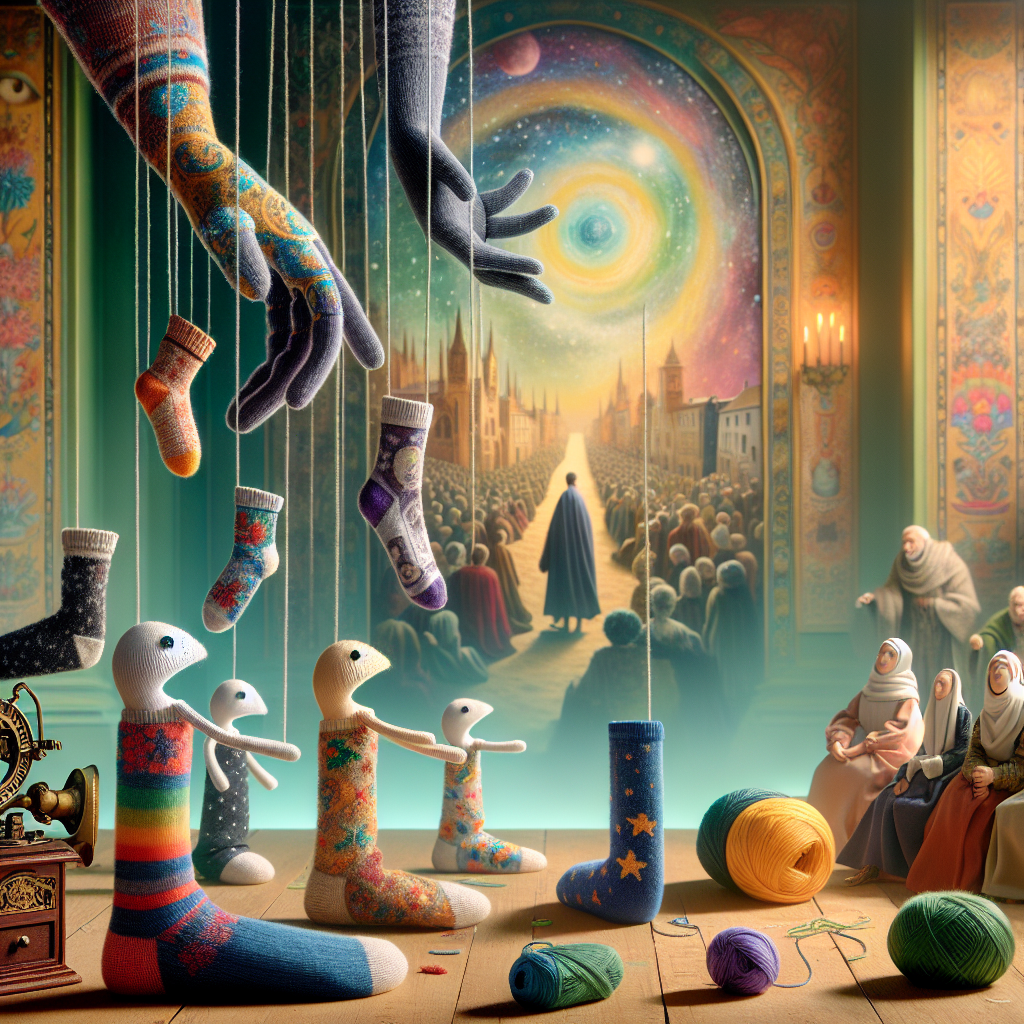
Sock Puppets, Shakespeare, and the Existential Void: How Yarn Creatures Taught Me About Mortality (and Inadvertently Started a Cult)
When I was a child, I was fascinated by the idea of sock puppets. I loved the idea of creating a character out of a simple piece of fabric and bringing it to life. Little did I know that my fascination with sock puppets would lead me down a path of existential exploration and the creation of a cult-like following.
My journey began when I decided to combine my love of sock puppets with my love of Shakespeare. I created a series of sock puppet plays based on Shakespeare’s works, and soon I had a small but devoted following of people who were interested in my work. As I continued to explore the themes of mortality and the existential void, I found myself drawn to the idea of creating yarn creatures. These creatures, which I called “yarnies”, became a symbol of mortality and the existential void, and soon I had a cult-like following of people who were devoted to my work.
Through my exploration of sock puppets, Shakespeare, and the existential void, I have come to understand the importance of mortality and the power of storytelling. I have also come to understand the power of community and the importance of creating a safe space for people to explore their own existential questions. I am grateful for the journey I have taken and the people I have met along the way.
The Existential Crisis of Sock Puppets: How a Simple Toy Can Teach Us About Life and Death
The existential crisis of sock puppets is a surprisingly deep and complex topic that can teach us a lot about life and death. While it may seem like a silly topic, the implications of sock puppets’ mortality can be profound.
Sock puppets are a simple toy, but they can be imbued with a sense of life and personality. They can be used to tell stories, act out plays, and even provide comfort to children. But, like all living things, sock puppets are mortal. They can be torn, stained, and eventually worn out. This can be a difficult concept for children to understand, as it is for adults.
The mortality of sock puppets can be used to teach children about the cycle of life and death. It can help them understand that life is finite and that death is a natural part of life. It can also help them understand that death is not something to be feared, but rather something to be accepted and embraced.
The mortality of sock puppets can also be used to teach adults about the importance of living life to the fullest. It can remind us that life is precious and that we should make the most of it while we can. It can also remind us that death is inevitable and that we should not take life for granted.
The existential crisis of sock puppets is a surprisingly deep and complex topic that can teach us a lot about life and death. It can help us understand the cycle of life and death, and it can remind us to make the most of our lives while we can. So, the next time you pick up a sock puppet, take a moment to reflect on the lessons it can teach us about life and death.
Finding Meaning in the Void: How Shakespeare’s Tragedies Illuminate the Human Condition

Shakespeare’s tragedies are some of the most powerful works of literature ever written, and they offer a unique insight into the human condition. By exploring the depths of despair, loss, and suffering, these plays provide a window into the human experience and help us to make sense of our own lives. In this essay, we will examine how Shakespeare’s tragedies can help us to find meaning in the void and to better understand the complexities of the human condition.
First, we will look at how Shakespeare’s tragedies explore the depths of despair and suffering. Through his characters, Shakespeare shows us the pain and anguish that can come from loss, betrayal, and death. He also reveals the power of hope and resilience in the face of tragedy, and how even in the darkest moments, there can be a glimmer of light. By exploring these themes, Shakespeare helps us to understand the depths of our own emotions and to find meaning in our own struggles.
Second, we will examine how Shakespeare’s tragedies can help us to better understand the complexities of the human condition. Through his characters, Shakespeare reveals the complexity of human relationships and the power of love and loyalty. He also shows us how our decisions can have far-reaching consequences, and how our actions can shape our destinies. By exploring these themes, Shakespeare helps us to gain a deeper understanding of our own lives and to make sense of our own choices.
Finally, we will consider how Shakespeare’s tragedies can help us to find meaning in the void. By exploring the depths of despair and suffering, Shakespeare helps us to recognize the beauty and value of life, even in the darkest moments. He also reveals the power of hope and resilience, and how even in the darkest moments, there can be a glimmer of light. By exploring these themes, Shakespeare helps us to find meaning in the void and to better understand the complexities of the human condition.
In conclusion, Shakespeare’s tragedies are some of the most powerful works of literature ever written, and they offer a unique insight into the human condition. By exploring the depths of despair, loss, and suffering, these plays provide a window into the human experience and help us to make sense of our own lives. Through his characters, Shakespeare reveals the complexity of human relationships and the power of love and loyalty. He also shows us how our decisions can have far-reaching consequences, and how our actions can shape our destinies. By exploring these themes, Shakespeare helps us to find meaning in the void and to better understand the complexities of the human condition.
The Search for Purpose: Exploring the Existential Void Through the Eyes of a Sock Puppet
Introduction
We all have a need to find purpose in our lives. But what happens when we can’t find it? This is the existential void that many of us face, and it can be a daunting and overwhelming experience. To explore this void, we can look at it through the eyes of a sock puppet.
The Sock Puppet
The sock puppet is a simple creature, made of fabric and stuffing. It has no real purpose, no real identity, and no real place in the world. It is just a thing, existing in a state of limbo. But despite its lack of purpose, the sock puppet can still feel the emptiness of the existential void.
The sock puppet is aware of its own existence, but it doesn’t know what to do with it. It is constantly searching for something to fill the void, but it can’t seem to find it. It is stuck in a state of confusion and uncertainty, unable to move forward.
The Search for Purpose
The sock puppet’s search for purpose is a difficult one. It is constantly looking for something to give it meaning, but it can’t seem to find it. It is surrounded by a world that doesn’t understand it, and it feels like it is all alone.
But despite its struggles, the sock puppet never gives up. It continues to search for something to fill the void, and eventually it finds it. It discovers that its purpose is to bring joy and laughter to the world. It realizes that it can make people smile, and that is enough to give it a sense of purpose.
Conclusion
The sock puppet’s journey is a reminder that we all have a need to find purpose in our lives. We may feel like we are stuck in an existential void, but if we keep searching, we can find something to fill it. We may not know what our purpose is, but if we keep looking, we can find it.
Conclusion
The journey of creating sock puppets and exploring Shakespeare’s works has been an enlightening one. It has taught me about mortality and the existential void, and has inadvertently started a cult of people who are passionate about the same things. Through this experience, I have come to understand that life is precious and that we should make the most of it. We should strive to find meaning and purpose in our lives, and to make the most of the time we have.
You may also like
Archives
Calendar
| M | T | W | T | F | S | S |
|---|---|---|---|---|---|---|
| 1 | 2 | 3 | 4 | 5 | ||
| 6 | 7 | 8 | 9 | 10 | 11 | 12 |
| 13 | 14 | 15 | 16 | 17 | 18 | 19 |
| 20 | 21 | 22 | 23 | 24 | 25 | 26 |
| 27 | 28 | 29 | 30 | 31 | ||

Leave a Reply